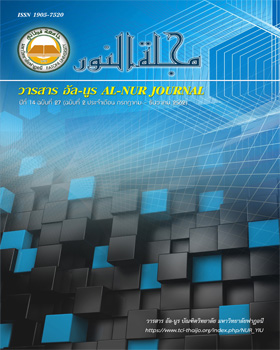HIKMAH Training Model: Fostering Creative Leadership for School Administrators of Islamic Private Schools in Southern Province of Thailand
Keywords:
HIKMAH training model, creative leadership, school administrators, Islamic private schools, southern ThailandAbstract
A newly creative leadership development HIKMAH training model was purposely designed and conducted to transform school administrators into an authentic creative leader in the innovation education. In this study, creative leadership is referred to the ability of school administrators to fuel vision, generate novel ideas, know what they want to do, have global and integrative perspective and combine collegiality to achieve the determined goals. Thus, this study aimed at examining the implications of HIKMAH training model for fostering creative leadership of school administrators as well as investigating their perceptions towards the model that was experimented on 30 purposively selected administrators of Islamic private schools affiliated with Assalam association in Southern Provinces of Thailand. Creative leadership behaviors of school administrators emerged during training were observed from given activities i.e., post-it events, drawing mind map, and school project proposal presentation. Perceptions towards HIKMAH training model for developing creative leadership was examined from questionnaires. The result of the study indicated that, throughout the training process, the school administrators displayed their creative leadership behaviors, thus assuring the effectiveness of the HIKMSH training model. Rather, positive perceptions towards the conducted training was empirically reaffirmed. The study then gives some implications for further practices in developing creative leadership attributes for school administrators.
References
Ashley, Greg C. & Reiter-Palmon, Roni. (2009). "Review of Creative leadership: Skills that drive change" (2009). Psychology Faculty Publications. Paper 53. Retrieved August, 1, 2017 from http://digitalcommons.unomaha.edu/psychfacpub/53
Boochom Srisa-ard. (1992). Karn Wichai Beang Ton (in Thai) - Basic Research (2nd ed.). Bangkok; Suviriyasan.
Creative leadership: A challenge of our times (PDF Download Available). Available from: https://www.researchgate.net/publication/249014997_Creative_leadership_A_challenge_of_our_times [accessed Apr 22 2018].
Csikszentmihalyi, M. (1997). Creativity: Flow and the psychology of discovery and invention. London, England: Harper & Row.
Harding, T. (2010). Fostering creativity for leadership and leading change. Arts Education Policy Review, 111, 51-53.
Jarvis, T.L. (2015). A mixed methods analysis on creative leadership and Missouri School Administrators. Doctoral thesis. Lindenwood University, Education Faculty.
Jiang, J. and Yang, B. (2015). Roles of creative process engagement and leader-member exchange in critical thinking and employee creativity. Social Behavior and Personlity, 43(2), 1217-1232.
Kaiser, L. & Halbert, J. (2009). Innovation and learning in the transformation of schools. London: Routledge.
Kearsley, G. (2010). Andragogy (M.Knowles). The theory Into practice database. Retrieved August, 1, 2017 from http://tip.psychology.org
Klimek, K. J., Ritzenhein, E. & Sullivan, K.D. (2008). Generative leadership: Shaping new futures for today’s schools. Thousand Oaks: Corwin Press.
Mathisen, G.E., Einarsen, S. and Mykletun, R. (2012). Creative leaders promote creative organizations. International Journal of Manpower, 33 (4), 367-382.
Pana, J., Wub, Q., Zhouc, W. and Loud, Y. (2015). When is the leader’s creativity related to the followers’ creativity? A cross-level examination in China. Innovation: Management, Policy and practice, 17(3), 364-382
Pathiphan, K. (2012). Model sommakan kerong sang pawa phunam chueng sang san kong pu borihan satan suksa arjiwa suksa (in Thai) – Structural equation modelling of creative leadership of administrators of vocational educational institution. Doctoral thesis. Konkaen University: Konkaen Province
Peterson, J. F., Frankham, N., Mcwhinnie, L and Forsyth, G. (2015). Leading creative practice pedagogy futures. Art, Design and Communication in Higher Education, 14(1), 71-86.
Phongsri-wat, S. (2005). Pawa Phunam: Terissadee lae pathibat (in Thai) - Leadership: Theory and Practice. Chiangrai Rajabhat Institution: Chiangrai Province
Puccio, G., Mance, M., & Murdock, M. (2011). Creative leadership: Skills that drive change. Thousand Oaks, CA: SAGE Publications, Inc.
Puccio, Gerard J., Murdock, Mary C., & Mance, Marie. (2007). Creative leadership: skills that drive change. Thousand Oaks, CA : Sage Publications.
Runco, M. A. (2008). Commentary: Divergent thinking is not synonymous with creativity. Psychology of Aesthetics, Creativity, and the Arts, 2(2), 93-96.
Sohmen, V.S. (2015). Reflections on Creative Leadership. International Journal of Global Business, 8(1), 1-14.
Tonkin, A. (2016). Leading schools for innovation and success: Five case studies of Australian principals creating innovative school cultures. Doctoral dissertation. The University of Melboume: Graduate School of Education.
UNICEF (n.d.). Children and young people in Thailand's southernmost provinces: Unicef situation analysis. retrieved on 12 April 2018 from http://www.unicef.org/thailand/ArtSouth.pdf.
UNICEF East Asia and Pacific Regional Office. (2014). Thailand case study in education in education, conflict and social cohesion. Thailand: Bangkok.
Wimol Jankaew. (2012). A creative leadership development model for the school directors of Suratthani primary education service area office 3.Doctoral Thesis. Rungsit University: Faculty of Education.
Yala Rajabhat University. (2006). Ko sano yuttasat kan pattana kunnaphap rong rian eakka chon son sadsana Islam (in Thai) - (Strategic proposal for quality improvement of Islamic private schools). Yala: Yala Rajabhat University.
Zhou, J. (2003). When the presence of creative coworkers is related to creativity: Role of supervisor close monitoring, developmental feedback and creative personality. Journal of Applied Psychology, 88, 413–422.



